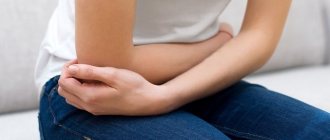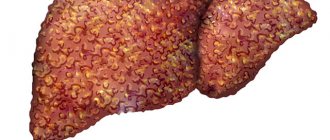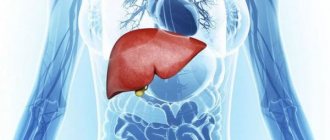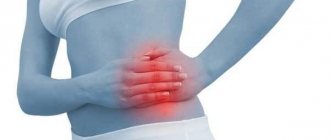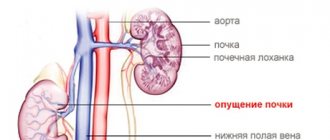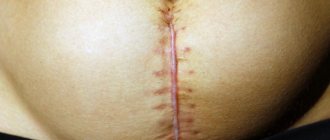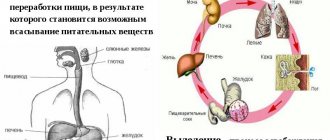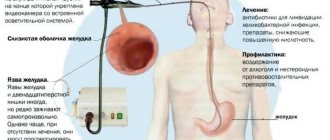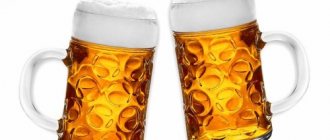Nature of pain
If you determine the nature of the pain, you can understand in which organ the trouble occurred. In medicine, the following types of pain are distinguished:
- Spicy. In the case when you can clearly say from your sensations that you are being cut with a knife, this indicates internal bleeding, blockage of a vessel, or rupture of a neoplasm.
- Paroxysmal. Characterized by wave-like sensations of pain, most often indicating muscle spasm.
- Moderate pain on a constant basis. Speaks about the pathology of internal organs, namely the liver, kidneys, spleen, etc.
- Shooting pain. First of all, it indicates disorders of the nervous system. In this case, there may be problems with the nerve roots in the spinal cord.
- Aching dull pain. This type of sensation indicates the presence of pathological processes in the liver, compression of organs, or problems in the structure of the ridge.
- Increasing pain. It is usually a symptom that indicates the development of an inflammatory process in the body.
- Cramping. Often caused by the process of muscle contraction in organs such as the stomach, gallbladder, small and large intestines, and bladder.
Definition of pathology
Only a qualified specialist can determine the cause of pain on the right side and prescribe proper treatment, so self-medication is not recommended.
In most cases, the cause of pain in the back and sides in this area is problems with the spine. This could be compression of any large nerves, damage to intervertebral discs, etc.
However, there are also internal organs, diseases of which lead to painful sensations.
- Firstly, these are the organs of the urinary system, kidneys and bladder.
- Secondly, such pain may appear due to the ill health of the digestive system, which includes the stomach, pancreas, intestines, liver and gallbladder.
Pain near the spine can be divided by nature. This can help in determining the causes of their occurrence just above the lower back, and in determining the severity of possible pathologies.
- Spicy. Such pain indicates very serious problems: organ damage, ruptures or perforations, internal bleeding.
- Strong. This type of pain differs slightly from acute pain and usually indicates diseases of the spine.
- Shingles. If the painful sensations go around the circumference, as if encircling, this may be a sign of problems with the gastrointestinal tract.
- Aching. Characteristic of constant and monotonous pain. Most often appears in liver diseases.
- Cramping. Pain that appears and disappears with a short interval. Indicates problems with the urinary system. The frequency of occurrence is associated with muscle contraction in the abdominal cavity.
- Pulling. Indicates traumatic injuries - sprains, hypothermia, etc.
- Growing. When the pain increases, becoming stronger, this may be a sign of various inflammatory processes.
Important! It should be noted that the pain will not always be exactly where the pathology arose; painful sensations can be reflected or projected. Self-diagnosis based on the location of the source of pain may be incorrect.
Localization location
Back pain is also classified depending on the location of the source of the problem. Sometimes a person can independently determine this place, but there are cases that the real source is not located where it hurts.
There are several options to determine the initial focus of the disease:
- If you have pain on the right side under the shoulder blade, this indicates pinching of one of the nerves, the presence of an oncological process in the lung, pleurisy or pneumonia.
- When the lower edge of the ribs bothers you, these are mainly problems associated with the liver, gallbladder or pancreas.
- Pain in the back center right indicates kidney disease.
- The lumbar region indicates possible spinal injuries or the presence of a hernia. In addition, there may be problems with the urinary system.
Causes: pain under the right shoulder blade from the back
Many people have back pain, and usually this fact does not cause serious concern for a person who is accustomed to letting things slide and turning a blind eye to the problem, reassuring himself and writing it off as “it will go away on its own, it hurts and stops, it happens.” But if back pain is periodic, you should not ignore this situation and it is important to find out the cause in time. If it hurts from behind, on the side of the back under the right shoulder blade, this can be a signal of a variety of ailments, which are sometimes quite difficult to diagnose, which is why it is dangerous.
Causes
The list of reasons that cause back pain is quite long. They are conventionally divided into several groups, which we will consider in more detail.
Diseases of the urinary system
Among the most common options that manifest as pain in the right side of the back are:
- Stones in the kidneys. Since this is a paired organ, it can hurt both on the right and on the left. In the worst case, in both sides at the same time. As a rule, stones form in people between the ages of 20 and 40 and are considered the most common urological disease. Some of the first symptoms:
- pain of an intermittent nature, which begins in the subcostal area, after which it radiates to the groin;
- cloudy urine with bloody discharge;
- increased body temperature;
- burning during urination;
- nausea and weakness.
- Cholecystitis. This is an inflammatory disease that relates to gallbladder diseases. Its inflammation causes a lot of unpleasant pain to a person. Main symptoms:
- dull pain that radiates to the right shoulder blade or arm;
an irresistible feeling of heaviness in the side and indigestion;
- decreased or complete lack of appetite;
- nausea, possible belching with an unpleasant bitter taste;
- a yellow tint to the skin appears.
- Pyelonephritis. This disease is associated with kidney pathology, when pain usually causes inflammation. The disease can be diagnosed by the following signs:
- aching pain from the back;
- high fever and body swelling;
- increased fatigue, nausea and frequent urination;
- tachycardia, dehydration, even fever is possible.
- Renal colic. Caused by blockage of the urinary tract. In this case, a person experiences severe pain in the back and back of the waist, which can radiate to other places.
- Kidney abscess. This is a purulent inflammation, which is not so common and is usually a consequence of pyelonephritis and urolithiasis. Manifests itself in the form of sharp pain, chills and severe thirst.
A person exhibiting symptoms of acute cholecystitis should be hospitalized as quickly as possible.
In critical cases of gallbladder disease, doctors may decide to immediately perform surgery.
Digestive system disorders
Gastrointestinal diseases can also manifest as pain in the right side of the back. These include:
- Acute pancreatitis. It is characterized by sudden pain on the right side, which spreads to the area of the shoulder girdle, heart and chest.
- Intestinal colic. This is a spasm of the intestinal muscles, which manifests itself as burning pain in the lumbar region. Periodically it decreases, then intensifies and after some time moves to the abdominal area.
- Appendicitis. The disease is caused by inflammation of the appendix. When the focus is located behind the cecum, unpleasant painful sensations occur in the lower right lower back.
Musculoskeletal problems
The main diseases of the musculoskeletal system that cause pain on the right side include:
- Lumbar osteochondrosis. This is a burning pain in the back that causes immobility for some time. Worsened by sneezing, awkward posture or coughing.
- Osteomyelitis. It manifests itself as a lingering pain in the right side, indicating the presence of a purulent-necrotic focus.
- Spinal injuries. Pain occurs when inflammatory or degenerative processes occur in the lower back.
- Neoplasms. They can be benign or malignant.
- Back muscle strain. Causes may include sudden movement or heavy lifting, a bad fall, heavy weight, or poor posture. Typical symptoms are back pain and inability to bend over freely.
- Sciatica. A common cause of back pain is pinched sciatic nerve. At the same time, the nature of the pain is different, ranging from aching to shooting.
- Postural disorders. Leads to compression of internal organs. In turn, this provokes pain. It entails a heavy load on the spine and a whole “bouquet” of problems.
- Spondylosis. The disease is caused by spinal deformation, which is caused by the proliferation of bone tissue. Causes aching, one-sided pain, sometimes accompanied by numbness in the legs.
Respiratory diseases
Pain in the right side can be caused by problems with the respiratory system. The main list of such diseases includes:
- Pneumonia (right-sided). It causes moderate pain on the right side just above the lower back, which gets worse with deep breathing or coughing.
- Lung or bronchial cancer. Pain and its intensity depend directly on the location of the tumor.
- Spinal cord diseases. The most common cause is a pinched nerve, which causes pain in the right side.
- Pleurisy. This is an inflammation of the pleura, in which the pain is cutting or stabbing. The level of pain increases during deep breathing and sudden movements.
- Pneumothorax. A disease during which gases accumulate in the pleural cavity of the lungs.
- Lungs' cancer. It is accompanied by constant unbearable severe pain, which occurs in the last stages of cancer, when the tumor grows into the pleura.
- Pulmonary infarction. A disease during which part of the lungs becomes dead and becomes saturated with blood when an artery is blocked by a blood clot. There is a sharp, very strong pain on the right under the shoulder blade. It is urgent to call an ambulance.
Pregnancy
During pregnancy, every woman should take special care of her health. If she suddenly has back pain on the right side, this may indicate:
- manifestation of signs of hepatitis;
- pyelonephritis;
- pathologies of the biliary tract;
- other less common diseases.
In any case, each of the options poses a huge danger to mother and child. Only physiological pain, which is a natural reaction to increased weight and stress on the body, is not dangerous. In this case, everything will normalize on its own after childbirth.
Symptoms
If the reason that the right side hurts and radiates to the back is a gastroenterological disease, then the clinical picture can be characterized as follows:
- Nausea and vomiting. These two symptoms are usually interrelated and often occur after eating food.
- Abdominal pain, the nature of the manifestation of which will depend on what exactly triggered its appearance.
- Increased flatulence, rumbling in the stomach.
- Off-flavor in the mouth.
- Belching with an unpleasant odor, heartburn.
- Violation of the process of defecation - diarrhea for no apparent reason, constipation. The consistency of stool also changes.
- Deterioration of appetite, and in some cases its complete absence.
- Weakness, increasing malaise.
- Low-grade body temperature due to food poisoning.
- Loss of body weight.
It should be understood that such symptoms accompany almost any gastroenterological disease, so treating yourself, without making a diagnosis, is strongly not recommended.
Pain in the right side behind can be caused by diseases of the liver and kidneys. Pathological processes from the genitourinary system are also not excluded.
The clinical picture can be characterized as follows:
- there is a nagging pain not only in the right side, but also in the lower back;
- unpleasant sensations in the lower abdomen, which often radiate to the groin area;
- problems with urination - frequent urges, painful, do not always bring relief, may be accompanied by a burning sensation;
- Women may experience menstrual irregularities;
- swelling of the legs, arms, face, which will be most clearly visible in the morning;
- yellowness of the skin;
- increased body temperature;
- weakness, increasing malaise.
If the cause of such a symptom is a disease of the musculoskeletal system, then the clinical picture will be characterized by pain in the back, limbs, limited mobility, and so on.
Due to the fact that the symptom of this type of pathology is not specific, if there are third-party signs, you should consult a doctor who will conduct an examination, make a diagnosis and prescribe the correct treatment.
Which doctor should I contact and should I call an ambulance?
If you have pain on your right side, it is recommended in any case to consult a doctor. Before doing this, you should listen to your body to understand exactly where the pain occurs, and also monitor possible accompanying symptoms, which include:
- weakness and fatigue;
- pain when urinating;
- elevated temperature;
- insomnia, nausea, cough;
- constipation or diarrhea;
- excessive sweating.
The list of specialists to whom patients turn includes:
- Gynecologist or urologist.
- Therapist.
- Neuropathologist.
- Gastroenterologist.
If the pain does not bother you too much and you can go to the hospital on your own, do not hesitate. During acute, sudden burning pain in the right side or under the rib, which is accompanied by weakness, dizziness, loss of consciousness, you should urgently call emergency services.
In some cases, an immediate reaction and calling an ambulance can save a person’s life - there are situations that require emergency surgical intervention and elimination of the root cause.
Medical therapy
Having found out why the right side behind the back hurts, the doctor prescribes treatment. The first task of the specialist is to eliminate pain - except in cases requiring urgent surgical intervention.
To relieve pain symptoms, non-steroidal anti-inflammatory drugs and analgesics are prescribed. Further therapy depends on the disease and its stage. For some diseases, massage, physiotherapy, and hydromassage baths will help eliminate pain. Such prescriptions are carried out only by a doctor.
Diagnostics
To understand what exactly worries a person and causes pain in the right side, you will need to diagnose the body.
The standard set of tests and examinations prescribed by the doctor includes:
- Studying medical history.
- Thorough physical examination.
- A set of clinical and biochemical blood and urine tests.
- Microscopic analysis of stool.
- X-ray and ultrasound.
- MRI and CT.
- Cystoscopy and cystography.
- Endoscopic diagnosis and bronchoscopy.
The results of these tests will help determine the disease and develop a method of treating it.
Diseases of the urinary organs
Against the background of relative well-being, renal colic appears. This is the name given to sharp, unbearable pain in the waist area and below due to injury to the ureter by a passing stone. Specialists diagnose acute kidney inflammation based on the nature of urination disorders, the results of laboratory tests of urine and ultrasound of the kidneys. Read about other symptoms, diseases and treatment of kidneys here.
With chronic inflammation in the right kidney, aching pain is localized in the right side, in the back below the waist. A person may not know that he has urolithiasis until he undergoes an ultrasound for another ailment. If there is sand in the kidneys, then the lower back hurts more during physical activity or uncomfortable body position.
Treatment of side pain
Depending on the diagnostic results and the specific diagnosis, treatment methods vary. This includes taking medications, massage, exercise therapy, etc.
Traditional treatment
Traditional treatment options include:
- Medications. To relieve pain in the right side of the back, nonsteroidal anti-inflammatory drugs that have an analgesic effect are often prescribed. Among the popular ones:
- Ibuprofen;
- Indomethacin;
- Butadion;
- Diclofenac;
- Ketoprofen.
- SWT treatment. In modern medicine, pain in the back is treated with a shock wave therapy device. This method is suitable for simple forms of disease. Usually 4-5 sessions are enough.
- Surgical intervention. Used in cases where a person needs emergency assistance.
- Manual therapy. One of the types of non-drug treatment, the essence of which is the use of special massage practices and techniques. The doctor uses his hands to influence the joints and spine, helping to relieve pain and spasms that pinch the nerve endings.
- Physiotherapy. This is a set of special physical exercises aimed at treating or rehabilitating a patient.
- Relaxation and massage. A type of relaxing massage that has a beneficial effect on the nervous system and relieves muscle tension.
Remember that such strong drugs have an impressive range of contraindications and side effects.
Folk remedies
Among the popular folk remedies that relieve back pain are:
- Homemade ointments. They need to be rubbed on the back or the area that is bothering you. The main purpose of these ointments is a warming effect. To prepare the ointment, take in equal proportions:
- millennium grass;
lavender;
- horsetail;
- marshmallow and dandelion roots (chopped).
- Cedar tincture. Used to warm up the back and relieve pain. To prepare cedar tincture with alcohol, you will need:
- half a cup of pine nut shells;
250 ml vodka.
- Rowan berry tincture. Eliminates pain in the lower back. To prepare it, take:
- 1 tablespoon of fresh rowan berries;
1 cup boiling water.
You will need 3 tablespoons of herbal mixture. Add 100 ml of boiling water and cook for about 5 minutes. Then the broth must be cooled and mixed with a fat base, which will require 75 g of pork fat and the same amount of vegetable oil. The ointment should be rubbed in when pain occurs.
Mix the ingredients and let them brew for 12 days. After this, the tincture can be used to rub the back and other sore areas.
Pour boiling water over the berries and leave for at least 4 hours. The infusion is taken 3-4 times a day until the pain goes away.
Damage to the digestive tract
With chronic inflammation in the liver and gall bladder, dull, aching pain occurs above the lower back in the right hypochondrium. Unpleasant sensations persist for weeks and months, years. To restore their full functionality, attention should be paid to the entire digestive tract. If parasites are diagnosed in the liver, then you need to take antihelminthic drugs.
Comprehensive treatment of parasitic disease:
- adherence to the “Table No. 5” diet;
- choleretic agent;
- enzyme preparation;
- antimicrobial agent;
- anthelmintic drug;
- enterosorbent to cleanse the intestines of toxins;
- probiotics to restore intestinal microflora;
- collection of herbs chamomile, rose hips, corn silk.
Cholecystitis is accompanied by pain in the abdomen on the right under the ribs, which radiates to the right shoulder blade and shoulder. Alcohol, fried and fatty foods provoke an attack. Pain from the pancreas is rarely felt from the back. However, this organ is interconnected with the stomach and gall bladder. The pancreas becomes inflamed when the acidity of the gastric juice increases and the bile duct is blocked. A severe pain attack occurs.
In the case of pathologies of the gallbladder, the pain is localized above the waist - in the right hypochondrium, and radiates to the right shoulder blade. It is recommended to follow a diet and avoid alcohol intake. To relieve spasms, take the drugs Buscopan and No-shpa.
Doctors usually suggest removal of the gallbladder to a patient with acute cholecystitis, as there is a high risk of developing peritonitis. A modern, low-traumatic method is endoscopic surgery. No incision is made, but the gallbladder is removed through small punctures.
Prevention
There is no specific prevention of side pain, as it occurs for various reasons. But there is a set of general recommendations, following which you can prevent troubles:
- When your work involves being in an office, provide yourself with appropriate comfortable conditions and a good chair with back support.
- Try to always keep your back straight.
- Correct any spinal disorders in a child from childhood.
- If you are overweight, you need to fight it. Many diseases and their complications arise precisely for this reason.
- Eat right, include healthy foods and vitamin complexes in your diet.
- Do not carry heavy bags or other heavy items unless necessary. If this is unavoidable, distribute the weight evenly.
- Spend enough time for physical activity and walks in the fresh air. Regular exercise will help maintain your health and strengthen your muscles.
- Stick to a proper daily routine. Set aside the right amount of hours for sound sleep and rest. Before going to bed, it is recommended to open the window and ventilate the room for 5-10 minutes.
- Don’t be nervous, try not to succumb to stressful situations and generally avoid them.
- If possible, try to go to the sea or to the forest every year. This will help improve your body’s health and not get sick throughout the year.
Remember that if necessary, it is better to consult a doctor rather than self-medicate. He will prescribe the necessary tests and create a step-by-step treatment for the disease. Therefore, if you notice back pain and other characteristic symptoms, immediately visit a medical facility.
What to do?
Aching pain that radiates to the side may indicate a variety of pathologies, as you have already seen. Therefore, if the pain is closer to the right side or in the lower back, then you should still visit a doctor.
All measures taken will only have a temporary effect, so you need to identify the root cause and focus on treating it.
What to do if there is pain in the right side from the back? Of course, it is advisable to follow the course of treatment chosen by the doctor so that it does not appear again in the future.
Therapy is usually complex, and therefore may include both medications and massage courses, exercise therapy, etc.
If the attack cannot be endured, the pain in the right side is so severe, you can take an analgesic.
Antispasmodics should be taken in cases where pain is concentrated near the spine, as this most likely indicates a pinched nerve and the spasm needs to be relieved.
You should not take any other medications, especially if the discomfort returns as soon as the effect of the analgesics wears off. In this situation, you immediately need to see a specialist.
Liver problems
Osteochondrosis
If your back hurts under the ribs, diseases of the digestive tract should be excluded. On the right side are the gallbladder, pancreas and liver. The inflammatory process in any of these organs is manifested by pain radiating both to the abdomen and to the back. If there are problems in the digestive tract, a person needs to visit a gastroenterologist.
Prolonged aching pain radiating to the back on the right should be a reason for examining the liver. With diseases of this organ, discomfort increases with physical activity and becomes weaker at rest. With liver diseases, pain in the right lower back worsens after consuming fatty, spicy foods and alcoholic beverages.
Very severe pain in the right lower back occurs due to a lumbar intervertebral hernia. They can spread from the source of inflammation to the popliteal region, lower leg, and to the back of the thigh. Often, when the disease occurs, people complain of numbness in certain areas of the lower extremities, tingling and burning in the toes, and paresis. The pain intensifies when walking, and becomes more tolerable in a lying position. Intervertebral hernias of the lumbar region are treated by an orthopedic surgeon.
Painful sensations of varying degrees of intensity in the area of the right hypochondrium can occur due to injuries to the spinal column during falls. If a person does not feel better within 1-2 days after the incident, he needs to consult a surgeon and exclude the possibility of damage to internal organs.
The inflammatory process located between the lower part of the liver and the intestines is called a liver abscess. The likelihood of occurrence increases sharply in those people who have had diseases such as appendicitis, cholecystitis, pancreatitis. In fact, a capsule with purulent contents appears. It is characterized by pain in the right hypochondrium on the right side of the back.
Pyelonephritis
Pain in the sides under the ribs in the lower back is a sign of chronic or acute pyelonephritis. If a person experiences discomfort only on the right side, pathology of the kidney located on this side should be excluded.
The acute course of pyelonephritis is accompanied by constant dull aching pain in the side, which intensifies when tapping the lower rib from the back, on the side of the affected kidney. In addition to painful sensations, the disease is accompanied by fever, chills, frequent urination, swelling, general loss of strength, nausea, and vomiting.
Chronic right-sided pyelonephritis is characterized by a weak aching pain, which becomes more intense when the body is hypothermic. Signs of the disease, in addition to discomfort in the lumbar region, also include a slight increase in body temperature and frequent urination. If, in addition to pain under the right hypochondrium, a person experiences other symptoms characteristic of acute or chronic pyelonephritis, he should immediately see a urologist.
The main symptom of this inflammatory kidney disease is the presence of pain on the right side of the back. Please note that starting immediately from the back, the pain may later have a girdling character. It is caused by a purulent process in the kidney. The temperature rises, sometimes above 38 degrees, and pain appears when urinating.
Problems in the spinal column
Severe back pain on the right or left side can be caused by serious changes in the structures of the spinal column and back muscles. Signs such as:
- Numbness of the lower or upper extremities is reported to indicate the development of osteochondrosis in one of the parts of the spine;
- Pale skin;
- Temperature increase;
- “Sharp” or “pulling” pains occur in an uncomfortable body position;
- Headache.
Complications of osteochondrosis manifest themselves in changes in gait, lameness, and disturbances in the structure of the musculoskeletal system.
Other ailments that become a source of back pain are:
- Intercostal neuralgia;
- Formed herniated intervertebral discs;
- Radiculitis;
- Curvature of the spine;
- Back injuries or muscle strains;
- Osteomyelitis.
In many cases, back diseases are interrelated, and one problem can trigger the development of another.
Inflammation of the appendix
Pain on the right side under the ribs in the back can provoke appendicitis. Inflammation of the appendix is characterized by constant moderate dull pain that intensifies with movement. Its localization is on the right side, but at the beginning of an attack it can occur in the navel, in the back under the rib, or cover the entire abdomen. In addition to painful sensations, appendicitis is also manifested by fever, loss of appetite, nausea, single vomiting, loose stools, and increased heart rate.
Inflammation of the lungs (pneumonia), begins with pain in the back, in the right hypochondrium. This disease cannot be neglected because it causes a cough and a temperature of up to 38 degrees.
Recently, cases of pneumonia with symptoms not similar to classic ones (atypical) have become more frequent.
- back pain on the right in the region of the ribs, intensifying when going up the stairs to the floor;
- pain when inhaling;
- complete absence of cough;
- sweating and fatigue;
- the presence of a low (37.2) temperature.
The cause of the disease is an infection that occurs in weakened people as a result of severe hypothermia or drinking ice-cold drinks, especially in the heat. It is important to note that any pneumonia is contagious. If you are visiting family or friends in the hospital, you should take a mask with you.
Diagnosis involves x-rays, bronchoscopy, general blood and sputum tests in the presence of a cough.
Localization and nature of pain
Have you been trying to heal your JOINTS for many years?
Head of the Institute for the Treatment of Joints: “You will be amazed at how easy it is to cure your joints by taking the product every day for 147 rubles ...
Read more "
Signs of a particular disease may manifest as pain and some associated symptoms:
- “dull” pain in the right side from the back occurs periodically and may not go away for a long time, regardless of body position. Unlike other types of pain, “dull” pain is easier to tolerate, but is less responsive to medication;
- “shooting” pain in the right side from the back usually appears suddenly and with high intensity, limiting the patient’s motor activity. Being in constant anticipation of new “stabbing” painful sensations, a person is in constant tension and becomes irritable;
- “aching” pain in the right side from the back often becomes a sign of radiating pain in the presence of problems with nearby organs or is the result of overstrain of muscle fibers during prolonged stay in an uncomfortable position;
- “pulling” pain in the right side from the back is similar to “dull” pain, becomes more intense for a short period of time with careless or sudden movements, and is sometimes accompanied by numbness of the limbs.
Detecting a problem at the location of pain:
- If the right side under the shoulder blade hurts, then you should pay attention to the respiratory system and spine;
- If pain is felt in the middle of the back, it may be due to the organs of the digestive tract;
- Pain as a result of problems with the urinary system is usually localized on one side, slightly above or below the lumbar region;
- The occurrence of pain along the entire right surface of the back may indicate problems with the spinal column, intestines, or be a consequence of muscle injury.
Due to the individual characteristics of each person, such as pain threshold, pain intensity, it is impossible to create a complete picture of the disease only from the patient’s words .
Why does the right side of a healthy person hurt?
It happens that discomfort on the right front and back appears in a more or less healthy person. As a rule, this manifests itself in the following situations.
- Pain in the side during or after physical activity. People unprepared for physical activity often note that they experience intense acute pain in the right hypochondrium during or after playing sports (for example, running, bending) or performing strenuous physical work, especially related to lifting, carrying, etc. . This is explained as follows: with such a load, adrenaline is released into the blood, the bile ducts are stretched due to stagnant bile. At this point in time, more blood enters the liver, its capsule increases, which causes stabbing pain on the right, which radiates to the back.
- Pain in the right side, under the ribs in the back, is almost always felt during physical activity immediately after eating.
- Spasms of the diaphragm during physical activity provoke a dull pain reaction under the rib in the back. It manifests itself with deep breathing, coughing, and sneezing. Such sensations are short-lived; it happens that a person feels better with slight pressure. When breathing is restored at the end of the workout, the pain stops.
Rehabilitation doctor Sergei Nikolaevich Agapkin understands what pain is talking about:
- Pain under the ribs in front and behind in women can be of physiological origin. For example, within a few days before the start of the next menstruation, spasms of the biliary tract occur, caused by hormonal imbalance, which is manifested by pain. Sometimes this condition is caused by the use of hormonal birth control pills. Pain in the right side can be both dull and acute.
- Pain in the right side of the back and side is often observed during pregnancy. This is explained by the peculiarities of physiology. In the last trimester of pregnancy, the uterus increases significantly, putting pressure on nearby internal organs. After childbirth, a healthy woman does not experience such pain.
- Often, healthy people experience discomfort in the back and sides after a night's rest. As a rule, this is not dangerous and stops if you replace uncomfortable sleeping accessories (mattress, pillow).
The cause of discomfort on the right side of the back is acute diseases
Experts determine possible causes by the location of the pain and accompanying symptoms. An acute pain attack on the right under the ribs develops with acute cholecystitis, appendicitis and a number of other diseases. Aching pain provokes various pathologies of the kidneys, gastrointestinal tract and spine. The body, through pain, sends a signal of danger, which must be recognized in order to begin treatment in a timely manner.
Acute diseases as causes of sudden pain in the right side from the back:
- inflammation or abscess of the right kidney;
- cholelithiasis;
- cholecystitis (read about its treatment in this article);
- appendicitis;
- pleurisy;
- pneumonia;
- osteochondrosis;
- myocardial infarction.
Important! A patient with sudden intense pain with suspected acute appendicitis, renal colic, or myocardial infarction must be hospitalized.
The abdominal form of myocardial infarction is more common in women. Pain occurs in the right hypochondrium, in the side from the back, in the navel area. Other symptoms of the disease: dizziness, shortness of breath, loss of consciousness. A painful attack begins after physical exertion, during emotional stress, at the age of over 45 years. A dangerous disease can lead to death if measures are not taken in time.
